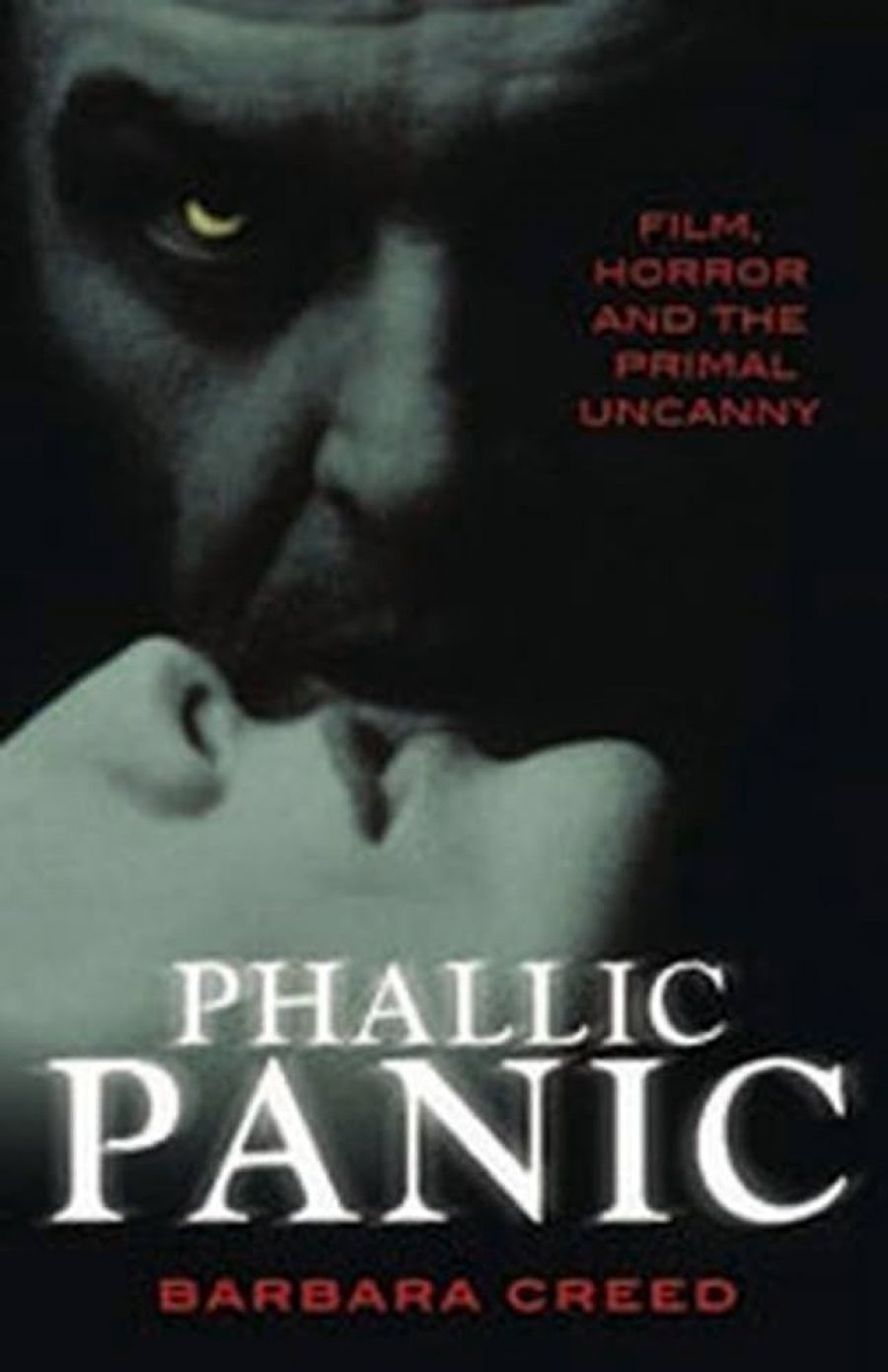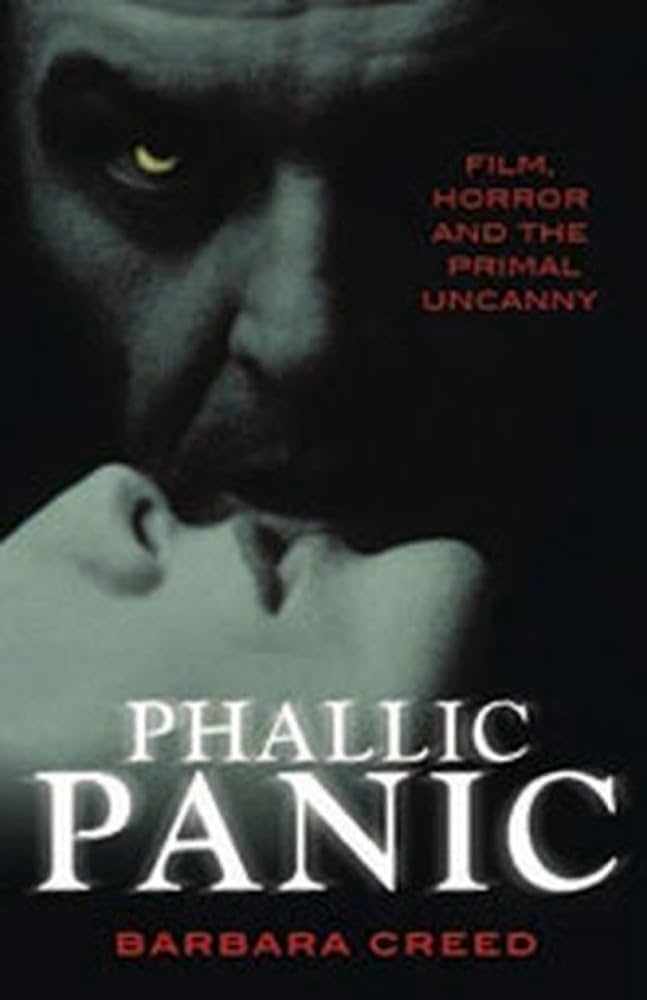
- Free Article: No
- Contents Category: Film
- Review Article: Yes
- Article Title: Womb monsters
- Online Only: No
- Custom Highlight Text:
What is a monster? Why are we so recurringly fascinated by graphic representations of the monstrous? And, in particular, what do cinematic images of male monstrosity tell us about the ways in which Western culture produces and views the categories of masculine and feminine? Barbara Creed’s new book is a direct extension of much of the lively work she did in The Monstrous-Feminine: Film, Feminism, Psychoanalysis (1993). In Phallic Panic, she moves from her earlier consideration of how we might interpret visions of female monstrosity as evidence of profound anxiety about the role of the woman in phallocentric society, particularly in her vagina dentata manifestations, to an examination of the cultural and psychological implications of male monsters.
- Book 1 Title: Phallic Panic
- Book 1 Subtitle: Film, horror and the primal uncanny
- Book 1 Biblio: MUP, $32.95 pb, 232 pp, 052285172X
- Book 1 Cover Small (400 x 600):

- Book 1 Cover (800 x 1200):

Once again making central use of Freud’s theory of the uncanny, in concert with Julia Kristeva’s notion of abjection, Creed argues that when the male is placed in the position of the monstrous, this implicitly links him in fundamental ways to what she terms the ‘primal uncanny’, a psychological and cultural constellation comprising of ‘woman, death, and the animal’. Thus, although the male monster may ostensibly appear to mirror phallocentrism’s dominance of the masculinised subject, in fact, according to Creed, that dominant subject is revealed as ‘compromised’ by its proximity to a loathsome femininity. Male monsters tend to bleed, ooze, suck, grow fur, harbour uterine fantasies of perverse gestations, thereby indicating a highly ambivalent set of desires to be, as well as to incorporate, an otherwise despised female body. The male monster, as it appears in variations of the horror or slasher film, graphically demonstrates the irruption of a kind of phallic panic – a panic that dominant masculinity may be haunted, even impregnated, at its very core of blood and viscera, by the femininity that it perpetually seeks to rape, murder or leech dry.
The chapters that expound this theory tend to be the most awkward in the book. There is a stylistic tendency to accrete rather than develop the complexity of the argument, by the repetition of key phrases – the primal uncanny, ‘woman, death, animal’ – or by imprecise qualifications, such as ‘extremely uncanny’, ‘particularly uncanny’. While this can result in a relatively easy-reading, almost conversational style – the primal uncanny for the general reader – it does perhaps blunt some of the potential incisiveness of what is also, unavoidably, a scholarly consideration of a complex issue: why, and how, popular cinema’s representation of the male monster is both a site of cultural fascination and a series of texts that demonstrate an explosion of anxiety about male and female roles, bodies and desires. Also, despite a fascinating extended reading of Freud’s Wolf Man case in the light of questions about sexual desire, incorporation, castration anxiety and metamorphosis into the werewolf, these theoretical chapters, with their emphasis upon the conjunctions of the uncanny and the abject, at times suggest a rather tired revisiting of some of the ideas and positions that were so compelling in The Monstrous-Feminine.
Creed’s writing is at its most engaging in her readings of the particular films or groups of films that she offers as case studies. In her discussion of Frankenstein-themed films, such as James Whale’s 1935 version, Altered States, but also in Dead Ringers and Alien: Resurrection, Creed describes the male protagonists as ‘womb monsters’, who demonstrate a kind of ‘feminised’ hysteria when they fail to replicate the role of reproduction. Films such as Dracula (1958 and 1992), Nosferatu, The Hunger and Interview with the Vampire are used to read the male figure as a ‘menstrual monster’, one who is rendered as ‘quintessentially uncanny’ by his associations with the bloody leakages of the female body, with motifs of doubling, suckling, oral sex, a porous boundary between life and death, and transformations into the animal. Again, although one might argue that the vampire figure viciously dominates and literally feeds upon the woman’s body, Creed’s analysis reveals the vampire as a dramatic enactment of the slippery porousness between ‘male’ and ‘female’. In the werewolf films (The Wolf Man, An American Werewolf in London, The Howling, Wolf), the literal slipperiness between man and wolf is a graphic portrayal, possible within the dream factories of the cinema, of the impossibility of keeping separate the categories of life and death, human and animal, the phallic male and the abject feminine of alterity. Similarly, the Nightmare on Elm Street films are discussed in terms of the motif of the male ghost who moves between life and death, sleep and waking, conscious and unconscious desires.
The final bracket of films that Creed discusses – Pandora’s Box, Jack the Ripper, From Hell, Silence of the Lambs – reveals the excessively violent and misogynist murderer as a ‘monster of fragmentation’ where ‘the threat he represents is displaced onto the cut and dismembered bodies of his female victims’. While on one level an extreme avatar of phallic repudiation and objectification of femininity, Creed’s analysis opens up a more complex account which links the very excessiveness of the Ripper’s assault upon the female body with those psychic processes of repudiation and denial. In the final assessment, the male monster, of whatever variety, who graphically enacts his murderous designs upon the body of the woman, simultaneously reveals his ambivalence and imbrication with the very thing he apparently despises. The uncanny, suggested Freud, shows us what should have remained hidden; in this sense, films of male monstrosity bring to coded light the waves of panic that haunt the fantasy of phallic dominance.


Comments powered by CComment